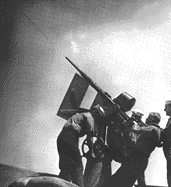A wide variety of training aids are used including mimeographed forms, motion pictures, practical demonstrations of fire equipment, breathing devices, breeches buoy, line-throwing gun. Every effort is made during this period to inspire the trainees with enthusiasm and pride in the service they have chosen.
They are given physical training so that they will be physically qualified for duty at sea. During the winter months this training is given on horses, vault boxes, parallel bars, lines and ladders in Bowditch Hall. During the warm season, the training is given on the outdoor Obstacle Course. The Obstacle Course is 560 yards long and comprises 38 obstacles spaced along six lanes. The men are required to move without pause over the entire course. The obstacles include log piles, hurdles, cargo nets, smooth and knotted lines, 15-foot wall, trough, incline and a 25 foot high enclosed escape hatch which the men enter through small portholes at the base, climb wooden ladders on the inside, emerge at the top and swing out and down the outer wall on knotted lines.
During courses to prepare them for emergencies, they are taught the seriousness of fire at sea, how to swim under burning oil [trainees at Avalon, Catalina Island, CA shown in adjoining illustration], what precautions to take to prevent fire, how to use fire-fighting apparatus, how to use lifeboats and the 39 standard articles of lifeboat equipment; how to rig and use rescue apparatus, gas masks and oxygen breathing equipment. In basic gunnery they learn to recognize and to handle the types of ammunition and guns used on merchant ships.
During instruction in gas masks, the trainees are given practical training in a gas chamber filled with sulphur dioxide gas. Before entering the chamber the men fit on gas masks. Then they remain in the vapor-filled room for several minutes. The mask is removed before leaving the chamber and the trainee is thus forcibly impressed with the effectiveness of the device.
DECK TRAINING
Seventeen courses are given in Deck Training plus three weeks of practical duty aboard one of the U. S. Maritime Service Training Ships which operate on Long Island Sound and Chesapeake Bay. The total advanced deck training period is seven weeks. The courses are:
 Gunnery
instruction is given by U. S. Navy instructors under the supervision of
a Navy Chief Gunner. Station equipment
includes these weapons:
Gunnery
instruction is given by U. S. Navy instructors under the supervision of
a Navy Chief Gunner. Station equipment
includes these weapons: